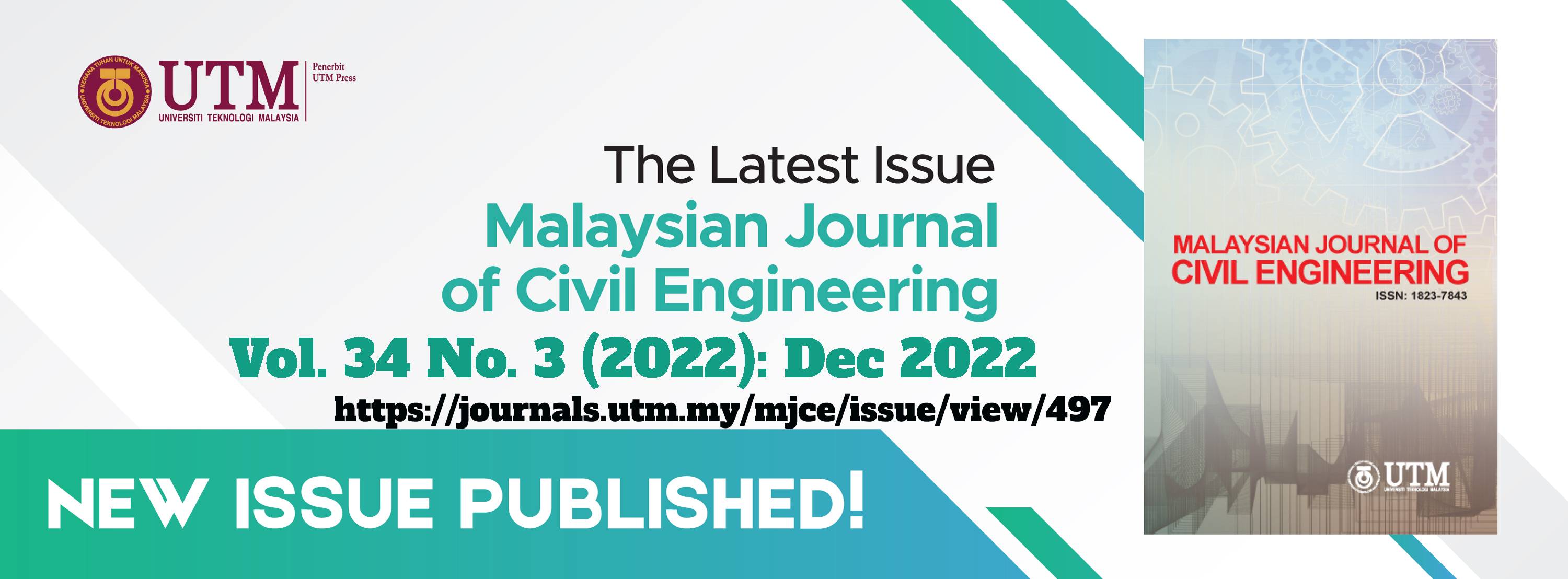EXPERIMENTAL PERFORMANCE OF RECYCLED AGGREGATE CONCRETE IN BANGLADESH CONTEXT
DOI:
https://doi.org/10.11113/mjce.v34.19008Keywords:
Recycled Aggregate Concrete (RAC), Compressive Strength, Natural Aggregate Concrete (NAC), sieve analysis, Specific Gravity.Abstract
Due to the deterioration of existing structures and the replacement of numerous low-rise buildings with comparatively high-rise ones, the amount of demolished concrete in Bangladesh is increasing. One of the major challenges of our present society is to construct environmental friendly sustainable structures with low-cost technology. Reusing concrete in the form of aggregate would lead to environmental and economical benefits. The research covers experimental work on Particle size distribution by sieve analysis, Fineness modulus, Specific Gravity, Water absorption, Bulk density, and percent void of recycled coarse aggregate. The goal of this study is to measure the compressive strength of recycled aggregates as a substitute for coarse aggregate. For this reason, several important experiments like a) slump test of concrete, b) compressive strength of cylinder concrete specimen are performed. Here, brick aggregates are used as coarse aggregate, the water-cement ratio (0.4) is kept the same, and 30%, 50%, and 70% natural aggregate are replaced by the same percentage of recycled aggregate without any admixture. The result shows that the compressive strength of recycled aggregate concrete (RAC) with 30% replacement of natural aggregate by recycled aggregate is near to the compressive strength of natural aggregate concrete (NAC). It is found that the specific gravity and bulk density of Recycled Concrete Aggregate (RCA) are 2.07 and 1163-1245 kg/m3 respectively which is significantly smaller than Natural Aggregate (NA). Recycled concrete aggregate (RCA) is discovered to have a larger percentage of pore volume and water absorption capacity than natural aggregate (NA), measuring around 13% and 36% respectively. The aggregate properties used in this research are in an acceptable range compared to other researchers.
References
B.B.o.S.-D.i.a. statistics, 2022. "https://worldpopulationreview.com/world-cities/dhaka-population," [Online], April 12, 2022.
T.H./.B.BEARD, 2021. "Exploration of Dhaka, Bangladesh," https://storymaps.arcgis.com/stories/cd249054ae7842fbac019c496f8fa479, June 7, 2021.
A. R. T. T. B. Nowrin Akhter Keya, 2018. "To Investigate the Effect of Using Recycled Concrete as Partial Replacement of Coarse Aggregate in Concrete Strength," research gate, Dhaka.
A. Z. K. A. H. M. Mohammed Tarek Uddin1, August 2013, "Recycling of Demolished Brick Aggregate Concrete as Coarse and Fine Aggregate," Third International Conference on Sustainable Construction Materials and Technologies, http://www.claisse.info/Proceedings.htm, Research gate, at: https://www.researchgate.net/publication/259863669.
A. International, 2017, Standard Test Method for Sieve Analysis of Fine and Coarse Aggregates" https://www.astm.org/c0136-01.html," [Online]. Aug 16, 2017.
H. Jamal, 2019. "Gradation Of Aggregates | Types of Aggregate Grading," AboutCivil.com, https://www.aboutcivil.org/gradation-of-aggregates, Oct 05, 2019.
U. J. A. M. R. A. S. Z. J. Md. Safiuddin, 2013, "Use of Recycled Concrete Aggregate In Concrete: A Review," Journal Of Civil Engineering And Management, 19(6): 796–810, https://doi.org/10.3846/13923730.2013.799093.
D. A. Advisor: Kuchma, 2015. "Investigation of fiber and cracking behavior for conventional and ultra-high performance concretes using x-ray computed tomography,"https://www.researchgate.net/publication/303863201_Investigation_of_fiber_and_cracking_behavior_for_conventional_and_ultra-high_performance_concretes_using_x-ray_computed_tomography .
N.a.B.S.Choo, 2003. Advanced Concrete Technology, https://www.sciencedirect.com/book/9780750656863/advanced-concrete-technology.
G. c. Benjamin E. Backus, 2022, Workability of Concrete " https://www.globalgilson.com/blog/what-is-workability-of-concrete ," [Online]. 1st February, 2022.
H. A. S. M. Z. Erfan Najaf, 2022, "Effect of waste glass powder, microsilica and polypropylene fibers on ductility, flexural and impact strengths of lightweight concrete," International Journal of Structural Integrity, 13: 511-533, https://doi.org/10.1108/IJSI-03-2022-0039.
E. N. a. H. Abbasi, 2022, "Using Recycled Concrete Powder, Waste Glass Powder, and Plastic Powder to Improve the Mechanical Properties of Compacted Concrete: Cement Elimination Approach,"Hindawi, 2022, Volume 2022, Article ID 9481466, 12 pages, https://doi.org/10.1155/2022/9481466.
M. O. a. S. M. Z. Erfan Najaf, 2022, "Improving nonlinear behavior and tensile and compressive strengths of sustainable lightweight concrete using waste glass powder, nanosilica, and recycled polypropylene fiber," Nonlinear Engineering 2022; 11: 58–70, https://doi.org/10.1515/nleng-2022-0008, Available: https://www.degruyter.com/document/doi/10.1515/nleng-2022-0008/html.
S. M. Z. &. E. N. Maedeh Orouji, 2021, "Effect of glass powder & polypropylene fibers on compressive and flexural strengths, toughness and ductility of concrete: An environmental approach," ScienceDirect, 33: 4616-4628, https://doi.org/10.1016/j.istruc.2021.07.048, Available: https://www.sciencedirect.com/science/article/abs/pii/S2352012421006640?via%3Dihub.
















